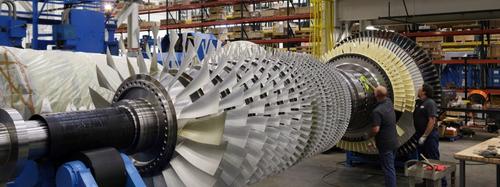Seeking the Big Data that Makes a Difference 26576
Not all big data is useful. This panel of experts discusses how to determine what big data makes a difference.
June 10, 2016
Manufacturers are generating tons of product data as well as data on the machines used to produce the product. Add the data coming back from customers who are using the product and the result can be an overwhelming flow, prompting the question: What data matters? A panel of big data experts will wrestle with that question at the Automation Technology East show in New York next week.

With big data, customers get more than the turbine and maintenance for it. They also get energy efficiency or flexibility during the operation of the turbine.
(Source: Siemens)
The panel, Making Sense of Big Data: Determining Actionable Data & Your Roadmap for Utilization, will be moderated by Benjamin Varghese, startup advisor for VR. Panelists include Bill Boswell, senior director of cloud services at Siemens PLM Software; Brian Cohn, PhD, chief data scientist at Kaspect; Daymon Thompson, automation product specialist at Beckhoff Automation; and Matt Wells, general manager for automation software at GE Digital.
The panelists will discuss strategies to improve Big Data analytics for efficient accessibility and utilization. They will map out the future of your collected data, and they will also discuss the data centers that store the data and how secure they are against cyber attacks.
 Talk to Your Plants. Learn how to standardize communication between equipment, controls, systems, and the humans who run them at Industry 4.0: Smart Manufacturing, part of ATX East. June 16 in New York. Register here for the event, hosted by Design News’ parent company UBM. Enter promo NY16DN for a FREE Expo pass & 20% off Industry 4.0 Conference.
Talk to Your Plants. Learn how to standardize communication between equipment, controls, systems, and the humans who run them at Industry 4.0: Smart Manufacturing, part of ATX East. June 16 in New York. Register here for the event, hosted by Design News’ parent company UBM. Enter promo NY16DN for a FREE Expo pass & 20% off Industry 4.0 Conference.
Each panelist brings a new story in how to choose the most meaningful Big Data. At Beckhoff Automation, much of the machine data is kept right at the machine where it is used to monitor the machine’s performance. “We look at the machine side of big data. You collect massive amounts of data, but how do you use it? We keep it at the machine itself. Instead of taking raw sensor data outside, we use it at the site of the data, looking at a smaller subset for condition monitoring,” Thompson told Design News. “We look at whether the operation is taking longer than it should, and then we send a notification to the maintenance team, to someone who can analyze what’s going on.”
At GE the focus is on the performance of products in the field such as jet engines. “Big data is driving reliability and performance. We pull tons of data off our jet engines. That rich data makes it possible to predict performance. We also use big data for schedules and maintenance. We’ve launched a predict platform to standardize the data residing in the cloud,” Wells told us. “We manage big data for GE customers as well as GE competitors. We have proprietary algorithms, and we make it available in the market.”
READ MORE ARTICLES ON BIG DATA:
GE also uses its data analytics to assess the health of livestock. “We applied big data to cows. We can measure how much they’ve eaten,” said Wells. “We run the analytics across the herd, so we can measure whether the cow is getting sick. The human being can’t process the information. You need data to do the insights.”
Cybersecurity in the Big Data Cloud
Security is always a hot topic when you’re connecting product data or plant data to the cloud for processing. "When it comes to cloud security, we adhere to cloud security standards," Varghese said. “Not being in the cloud is a policy of avoidance. It’s easier to get into a customer’s network rather than the cloud.”
Moving to the cloud is not always a simple matter. Many countries have regulation on the use of data in the cloud. “The cloud is more secure. It’s connecting the equipment to the cloud that is always the worry. Is the company ready to tackle moving to the cloud and following data regulations that some countries require for the cloud?” said Wells.
At Siemens, engineers look for opportunities to use design and production data in combination with field data to get a fuller picture of the product’s performance. “Companies have to deal with dark data, data that is collected in a system for one purpose such as building the product, and not used again,” said Boswell. “We close the loop back in with the dark data.”
Rob Spiegel has covered automation and control for 15 years, 12 of them for Design News. Other topics he has covered include supply chain technology, alternative energy, and cyber security. For 10 years he was owner and publisher of the food magazine Chile Pepper.
About the Author(s)
You May Also Like





